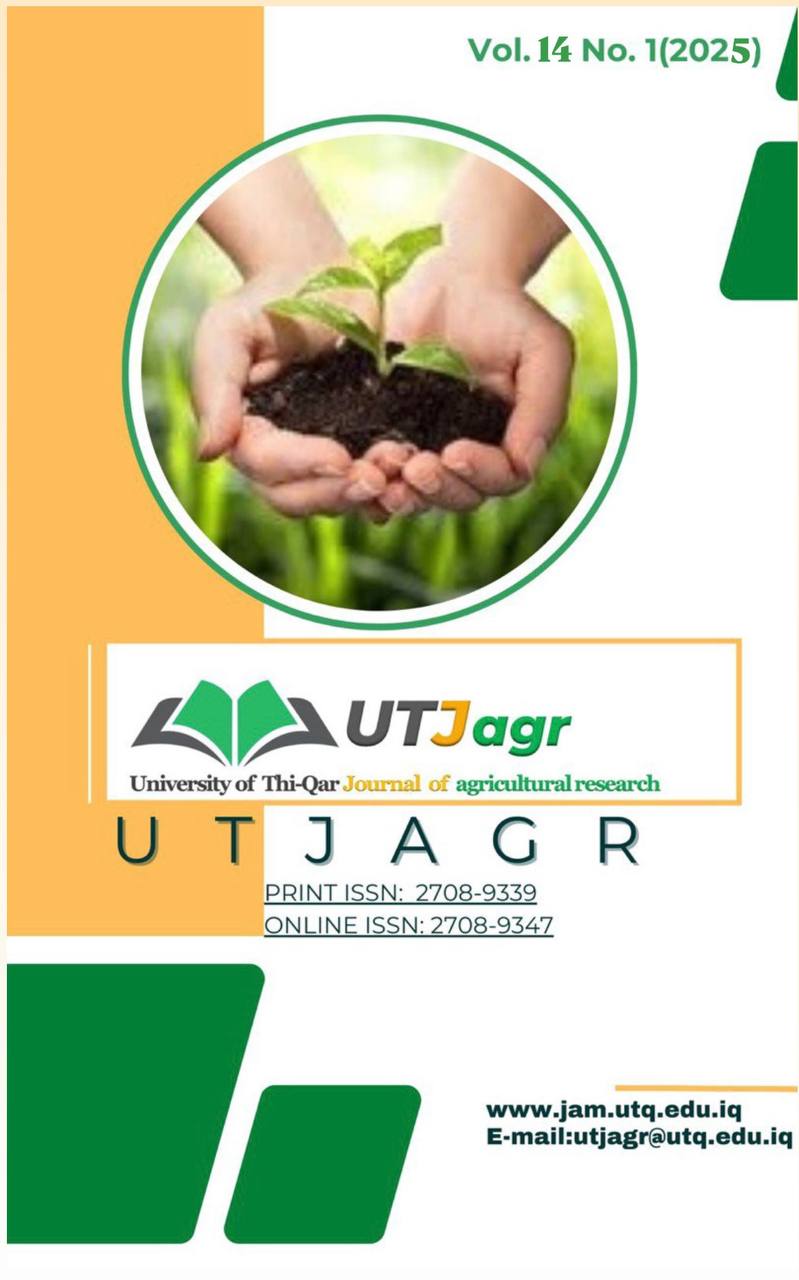Multifactorial Stressors: Linking Fusarium Infection, Heavy Metals, and Salinity to Physiological Dysfunction in Tomato Solanum lycopersicum L.
DOI:
https://doi.org/10.54174/s0tkd624Keywords:
Fusarium oxysporum f. sp. lycopersici, Oxidative stress, Heavy metal, Salinity stress, TomatoAbstract
Tomato (Solanum lycopersicum L.) is a globally strategic crop, vital for food security and agricultural economies, yet its productivity is increasingly threatened by biotic and abiotic stresses. This study investigates the combined effects of Fusarium oxysporum f. sp. lycopersici (FOL), heavy metals (cadmium, cobalt, chromium and lead), and salinity on biochemical and growth parameters of the Yassamen tomato variety. Results revealed that FOL infection alone significantly reduced chlorophyll content (3.68 to 2.96 mg.g⁻¹) and total soluble carbohydrates (2.51 to 1.95 mg.g⁻¹), while elevating oxidative stress markers: hydrogen peroxide (H₂O₂, 0.18 to 0.58 µmol.g⁻¹) and malondialdehyde (MDA, 0.13 to 0.44 nmol.g⁻¹). Synergistic interactions exacerbated stress responses, with lead and high salinity (12 dS.m⁻¹) causing the most severe declines in chlorophyll (1.61 and 1.41 mg.g⁻¹, respectively) and carbohydrates (1.40 and 1.32 mg.g⁻¹). Proline accumulation peaked under combined stresses (2.20 µmol.g⁻¹ with FOL + 12 dS.m⁻¹), suggesting a partial compensatory mechanism. Growth parameters were severely inhibited: plant height decreased by 36.8% under FOL, plummeting further to 68% with FOL + 12 dS.m⁻¹, while root dry weight dropped by 63% under FOL + chromium. These findings underscore the compounded damage caused by FOL, heavy metals, and salinity, linked to oxidative membrane damage, photosynthetic impairment, and resource diversion to stress mitigation. To safeguard tomato productivity in stress-prone regions, integrated strategies such as developing stress-tolerant cultivars, optimizing soil remediation, and managing pathogen load are urgently recommended.
Downloads
References
Abdelaziz, A. M., Elrefaey, A. A., Sharaf, M. H., Al-Qthanin, R. N. and Attia, M. S. (2024). Enhancing tomato plant immune responses to Fusarium wilt disease by red seaweed Jania sp. Sci. Rep. 14(1), 18052. https://doi.org/10.1038/s41598-024-67233-0
Aboukarima, A.M., Zayed, M.F., Minyawi, M., Elsoury, H.A. and Tarabye, H.H.H.(2017). Image analysis-based system for estimating cotton leaf area. Asian Res. J. Agri, 5(1):1-8. https://doi.org/10.9734/ARJA/2017/33626
Al-Aradi, H.J., Al-Najjar, M.A., Awad, K.M. and Abass, M.H. (2020). Combination effect between lead and salinity on anatomical structure of date palm Phoenix dactylifera L. Seedlings. Agrivita. 2020; 42(3): 487–498. https://doi.org/10.17503/agrivita.v42i3.2511
Al-Jabary, K. M., Neama, J. D. and Abass, M. H. (2016). Seasonal variation of heavy metals pollution in soil and date palm Phoenix dactylifera L. leaves at Basra governorate/Iraq. Inter. J. Sci. Res. in Environ. Sci. 4 (6).
Anjum, A., Shaheen, S., Habiba, Rahman, A., Naz, S. and Shafique, K. (2024). Impact of bioinoculants on growth enhancement, physicochemical characteristics, biochemical profiles, and enzymatic defense mechanisms in tomato (Lycopersicum esculentum). Sci. Rep. 14(1), 27350. https://doi.org/10.1038/s41598-024-78485-1
Arnon, D.I. (1949). Copper enzymes in isolated chloroplasts, polyphenoxidase in Beta vulgaris. Plant Physiol. 24:1-15.
Aybeke, M. (2017). Fusarium infection causes genotoxic disorders and antioxidant-based damages in Orobanche spp. Microbiol. Res. 201, 46–51. https://doi.org/10.1016/j.micres.2017.05.001
Bates, L.S., Waldren R.P. and Teare I.D. (1973). Rapid determination of free proline for water stress studies. J. Plant and Soil. 39:205-207.
El Ghazali, G.E.B. (2020). Suaeda vermiculata Forssk. ex J.F. Gmel.: structural characteristics and adaptations to salinity and drought: a review. Inter. J. Sci., 9: 28–3. https://doi.org/10.18483/ijSci.2268
FAOSTAT Crop and livestock products. Available online: https://www.fao.org/faostat/en/#data/QCL (accessed on 30 April 2025).
Feng, L., Zhao, G., Sun, R., Wang, J., Sun, T., Xing, S., Lian, W. and Zhao, Y. (2023). Dynamic changes in cell wall-degrading enzymes and physio-biochemistry of ginseng in response to Fusarium oxysporum infection. Europ. J. Plant Pathol. 165(3), 569–578. https://doi.org/10.1007/s10658-022-02628-1
Gabash, H.M., Resan, A.Z., Awad, K.M., Suhim, A.A. and Abdulameer, A.H. (2024). Biochemical Responses of Date Palm Phoenix dactylifera L. to Combined Stress of Salinity and Nickel. Basrah J. Agric. Sci. 37(1): 236-246. http://doi.org/10.37077/25200860.2024.37.1.18
Hanif, S., Ali, S., Chaudhry, A.H., Sial, N., Marium, A. and Mehmood, T. (2025). A review on soil metal contamination and its environmental implications. Nature Envir. Pollut. Technol. 24(1), D1684. https://doi.org/10.46488/ NEPT.2025.v24i01.D1684
Haque, Z., Pandey, K. and Zamir, S. (2023). Bio-management of Fusarium wilt of tomato (Fusarium oxysporum f.sp. lycopersici) with multifacial Trichoderma species. Discov. Agric. 1, 7. https://doi.org/10.1007/s44279-023-00007-w.
Heath, R.L. and Packer, L. (1968). Photoperoxidation in isolated chloroplasts. I. Kinetics and stoichiometry of fatty acid peroxidation. Arch Biochem. Biophys. 125:189–198. https://doi.org/10.5772/intechopen.88095
Jones, J.B. (1984). Plants. In: Williams S. (ed.). Official methods of analysis of the association of official analytical chemists. Arlington, Virginia 22209, USA. pp 38–64.
Kakaei, H., Amirinejad, A.A. and Ghobadi, M. (2023). Effect of salicylic acid foliar application on growth characteristics in tomato (Lycopersicon esculentum L.) under lead stress conditions. J. Soil and Plant Inter. 14(3). https://doi.org/10.47176/jspi.14.3.20162
Lungoci, C., Motrescu, I., Filipov, F., Jitareanu, C. D., Teliban, G.-C., Ghitau, C. S., Puiu, I. and Robu, T. (2022). The impact of salinity stress on antioxidant response and bioactive compounds of Nepeta cataria L. Agronomy (Basel, Switzerland), 12(3), 562. https://doi.org/10.3390/agronomy12030562
Madhi, Q.H., Abass, M.H. and Matrood, A.A.A. (2020). Heavy metals pollution of wheat fields (soils and leaves) sampled from Basrah and Maysan provinces.ES. Periódico Tchê Química, 17(35). https://doi.org/10.52571/ptq.v17.n35.2020.28_madhi_pgs_315_326.pdf
Muhorakeye, M.C, Namikoye, E.S., Khamis, F.M. et al. (2024). Biostimulant and antagonistic potential of endophytic fungi against Fusarium wilt pathogen of tomato Fusarium oxysporum f. sp. lycopersici. Sci. Rep. 14, 15365 https://doi.org/10.1038/s41598-024-66101-1
Mustafa, A.A., Abass, M.H. and Awad, K.M. (2021). Response of three tomato (Solanum lycopersicum L) varieties to different salinity levels. Plant Cell Biotechnol. Molec. Biol. 22 (41-42): 277-291.
Mustafa, M., Ruth, W., Mwangi, Z., Szalai, N., Kappel and László, C. (2025) Sustainable responses to open field tomato (Solanum lycopersicum L.) stress impacts, J. Agric. Food Res. 21:101825. https://doi.org/10.1016/j.jafr.2025.101825.
Natali, P.G., Piantelli, M., Sottini, A., Eufemi, M., Banfi, C. and Imberti, L. (2025) A step forward in enhancing the health-promoting properties of whole tomato as a functional food to lower the impact of non-communicable diseases. Front. Nutr. 12:1519905. https://doi.org/10.3389/fnut.2025.1519905
Pedrotti, L., Weiste, C., Nägele, T., Wolf, E., Lorenzin, F., Dietrich, K., Mair, A., Weckwerth, W., Teige, M., Baena-González, E. and Dröge-Laser, W. (2018). Snf1-RELATED KINASE1-controlled C/S1-bZIP signaling activates alternative mitochondrial metabolic pathways to ensure plant survival in extended darkness. The Plant Cell, 30(2), 495–509. https://doi.org/10.1105/tpc.17.00414
Razak, N.J., Abass, M.H. and Awad, K. M. (2024). Assessment of Heavy Metals Phytotoxicity on Seed Germination and Seedling Growth of Tomato Plants (Solanum Lycopersicum L.). Nat. Engin. Sci. 9(3), 163-176. https://doi.org/10.28978/nesciences.1606578
Ribeiro, J. A., Albuquerque, A., Materatski, P., Patanita, M., Varanda, C. M. R., Félix, M. do R. and Campos, M. D. (2022). Tomato response to Fusarium spp. Infection under field conditions: Study of potential genes involved. Horticulturae, 8(5), 433. https://doi.org/10.3390/horticulturae8050433
Sahu, A. K., Kumari, P. and Mittra, B. (2024). Fusarium induced anatomical and biochemical alterations in wild type and DPA-treated wheat seedlings. J. Pure and Appl. Microbiol. 18(1), 229–242. https://doi.org/10.22207/jpam.18.1.06
Sergiev, I., Alexieva V. and Karanov E.V. (1997). Effect of spermine, atrazine and combination between them on some endogenous protective systems and stress markers in plants. Proceedings of the Bulgarian Academy of Sciences 51:121–124.
Sharafi, S. and Salehi, F. (2025). Comprehensive assessment of heavy metal (HMs) contamination and associated health risks in agricultural soils and groundwater proximal to industrial sites. Sci Rep. 15, 7518. https://doi.org/10.1038/s41598-025-91453-7
Shi, Y., Zhang, Z., Yan, Z., Chu, H. and Luo, C. (2025) Tomato mitogen-activated protein kinase: mechanisms of adaptation in response to biotic and abiotic stresses. Front. Plant Sci. 16:1533248. https://doi.org/10.3389/fpls.2025.1533248
Sikandar, A., Mo, Y., Chen, B., Nishat, Y. and Wu, H. (2025). Influence of Meloidogyne incognita and Fusarium oxysporum on Growth, Physiological, Biochemical, and Root Morphology in Tomato Hybrids Cultivars. Agronomy (Basel, Switzerland), 15(4), 890. https://doi.org/10.3390/agronomy15040890
Singh, V.K., Singh, H.B., and Upadhyay R.S. (2017). Role of fusaric acid in the development of “Fusarium wilt” symptoms in tomato: Physiological, biochemical and proteomic perspectives. Plant Physiol. Biochem. 118, 320–332. https://doi.org/10.1016/j.plaphy.2017.06.028
Soliman, S.A., Hafez, E.E., Al-Kolaibe, A.M.G., Abdel Razik, E.S.S., Abd-Ellatif, S., Ibrahim, A.A., Kabeil, S.S.A. and Elshafie, H.S. (2022). Biochemical characterization, antifungal activity, and relative gene expression of two Mentha essential oils controlling Fusarium oxysporum, the causal agent of Lycopersicon esculentum root rot. Plants, 11(2), 189. https://doi.org/10.3390/plants11020189
Sora, S.A., Belew, D. and Etissa, E. (2024). Evaluation of tomato (Solanum lycopersicum L.) varieties under different salt stress levels. Inter. J. on Food, Agric. Natural Res. 5(2), 67–76. https://doi.org/10.46676/ij-fanres.v5i2.240
Suhim, A.A., Awad, K.M., Jaffer, O.N. and Abass, M. H. (2023). The impact of salicylic and jasmonic acid in mitigating salinity stress on date palm Phoenix dactylifera L. Barhi Cv. Basrah J. Agric. Sci. 36(1), 120-130. https://doi.org/10.37077/25200860.2023.36.1.10
Sultana, S., Altaf-Un-Nahar, M., Islam, M. R., Roy, M., Rahman, F., Azam, M. G., Brestic, M., Rhaman, M. S. and Karim, M. R. (2025). Foliar and root applications of salicylic acid alleviate salinity stress by modulating morpho-physiological and biochemical aspects in tomato (Solanum lycopersicum). Discover Plants, 2(1). https://doi.org/10.1007/s44372-025-00117-3
Ur Rahman, S., Qin, A., Zain, M., Mushtaq, Z., Mehmood, F., Riaz, L., Naveed, S., Ansari, M. J., Saeed, M., Ahmad, I. and Shehzad, M. (2024). Pb uptake, accumulation, and translocation in plants: Plant physiological, biochemical, and molecular response: A review. Heliyon, 10(6), e27724. https://doi.org/10.1016/j.heliyon.2024.e27724
Velmurugan, A., Swarnam, P., Subramani, T., Meena, B. and Kaledhonkar, M.J. (2020). Water Demand and Salinity. Desalination - challenges and opportunities. Intech Open. https://doi.org/10.5772/intechopen.88095
Watanabe, S., Kojima K., Ide Y. and Sasakii S. (2000). Effect of saline and osmotic stress on proline and sugar accumulation in Populus euphratica in vitro. Plant Cell Tissue Organ Cult. 63:199-206. https://doi.org/10.1023/A:1010619503680

Downloads
Published
Issue
Section
License
Copyright (c) 2025 Mohammed Abass, Nisreen Razak, Khairullah Awad

This work is licensed under a Creative Commons Attribution-NonCommercial-ShareAlike 4.0 International License.







1.png)

